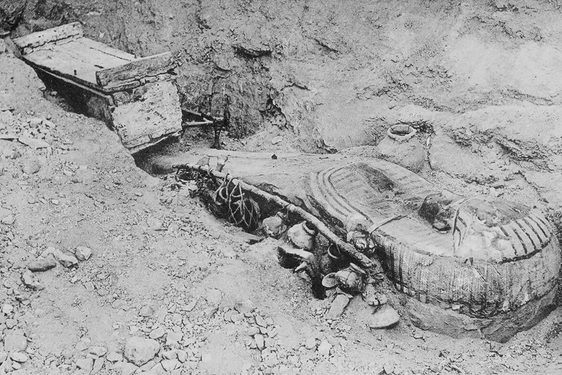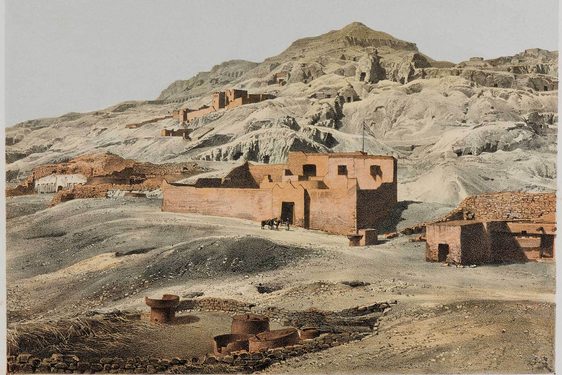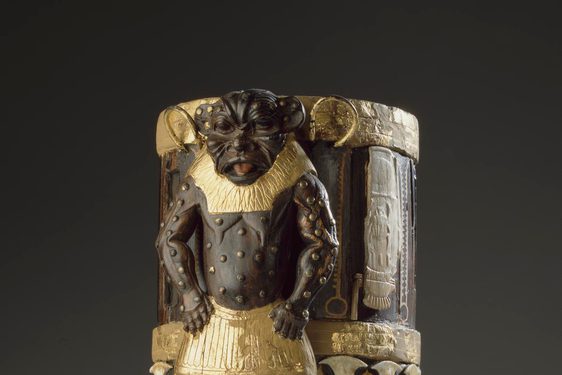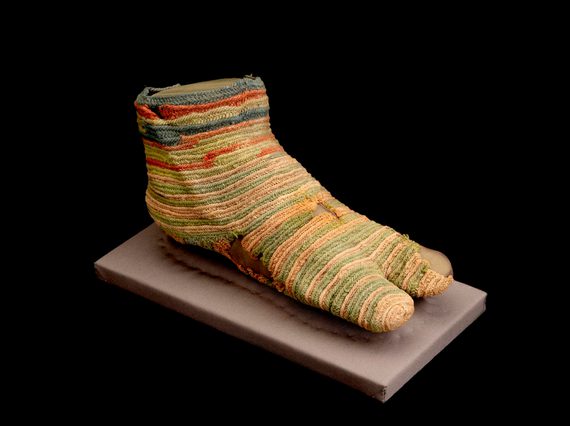
The lost sock: An ancient Egyptian textile
News Story
In 2019 National Museums Scotland opened a redeveloped Egyptian gallery. Many of the objects chosen for the new space had never been on display before. Among them were some fascinating textiles that intimately connect us with the ancient people who used or wore them, giving a sense of lives lived long ago: a 1,500 year old sock was one of the most intriguing of these.
The striped woollen sock now has eleven holes in it, but is in remarkable condition for a textile that dates to approximately AD c300–600. The sock was acquired by the Museum in 1911 from the former collection of banker Frederick George Hilton Price (1842 – 1909). Price recorded it as having come from Akhmim, an important Egyptian textile manufacturing centre since antiquity to the present day. It was probably excavated from an ancient cemetery where thousands of other textiles have been found, preserved by the dry desert conditions.
Conservation treatment of the sock took 105 hours, the equivalent of one person working on it solely for over a month.
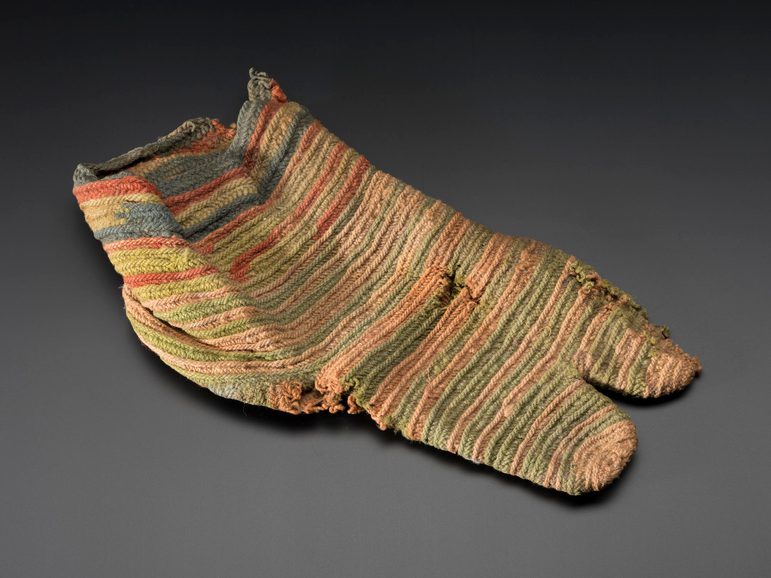
Egyptian sock before conservation. Museum reference A.1911.315.
A sock made for sandals
The most notable feature of the Egyptian sock is the divided toe. The intention was likely to have been to put the big toe in one side and four smaller toes in the other. It is believed that socks of this type were designed to be worn with thonged sandals.
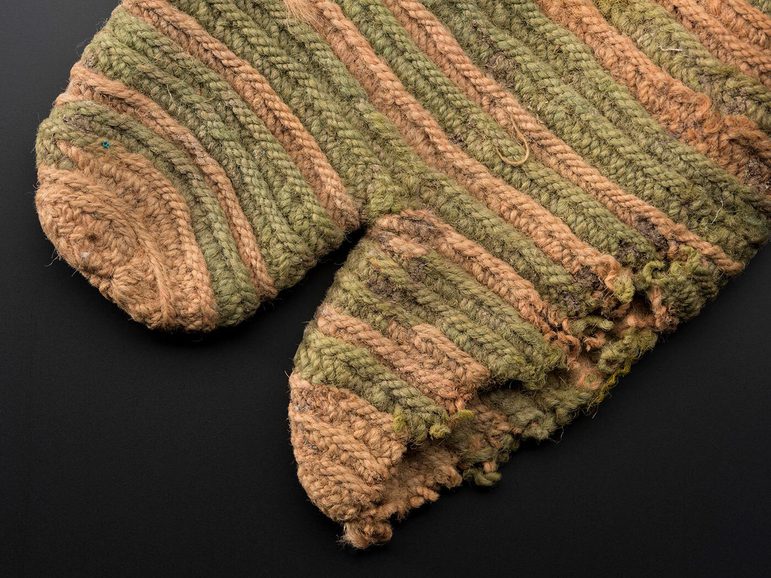
Detail of the Egyptian sock's split toe design. Museum reference A.1911.315.
The sock was probably constructed starting at the tip of the toes. The technique, called Nålebinding, is visually similar to knitting and can be mistaken for it, but is actually a single needle technique more akin to sewing. Finite lengths of yarn are threaded through a small loop and then knotted in the process of completing a stitch and starting a new one. At the top of each toe, the stitches would have been worked with a long, broad needle to the round shape needed by pulling up a line of stitches tightly. Once the yarn becomes too short to work new stitches, a new length would be tied on to continue the work and any loose ends cut off to neaten. The knot and loop technique produces an attractive, well balanced, flexible ribbed cloth with distinct twill type patterning between the ribs. It was certainly fit for purpose; the rib would have allowed the material to stretch and be able to move comfortably over the complex shape of a foot with ease.
Whilst linen was used in Egypt for most of antiquity, wool only became common after the Roman conquest in 30 BC. Here, four different coloured wools were used to compose non-continuous stripes of colour. Care was taken to ‘tip’ the ankle with blue yarn, but lower down stripes often change colour mid-way, suggesting that using up yarn was more important than balancing the design.
Assessing the condition of the sock
The conservation work on the sock began in the standard way with examination and photography. At this stage we are getting to know the object and two or three different treatment options may be proposed depending on the needs of the object, its original use, and if it is wanted for loan, display, or storage. The condition notes recorded included general and specific observations:
"The overall condition of the sock is poor. It is dry and the fibres friable. The sock is squashed very flat and brittle folds have formed in places. There is heavy ingrained and particulate grey dirt soiling and stains throughout. Hardened brown coloured soiling and stains are heaviest along the length of the inside sock; the soiling pattern is inconclusive though could be related to burial...all the holes are fraying and vulnerable to further damage. The holes are causing considerable structural instability to the overall form, and the object must be handled with great care to prevent further damage and loss."
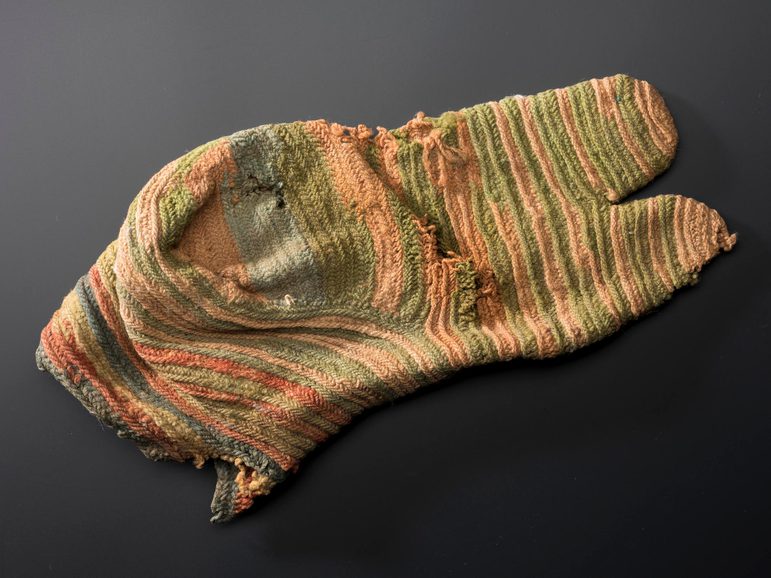
Reverse of the Egyptian sock before conservation. Museum reference A.1911.315.
Examining the fibres
The sock was indeed almost two-dimensional. It was in a vulnerable state due to the instability caused by the combined effect of centuries of lying folded and crushed as natural degradation processes, catalysed further by acidic soiling, weakened the internal and external structures of fibre and yarn. In this tender state the sock was quite distorted, and access to its interior was nearly impossible.
Further examination was carried out with a digital microscope to assess in more detail how degradation processes had affected the fibres. The most distinctive outward feature of magnified new wool fibres are overlapping scales that form a sheath around an internal structure. New scales are very porous, but with wear, washing, and time the scales abrade and become quite smooth. In addition to the expected glassy outer appearance of the socks aged fibre were microscopic particles of mineralised salts and copper corrosion. A few of these particles were probably related to a nail that had been put right through the toe, presumably to hang it at some previous time (disclaimer – we don’t do that now!).
Reshaping the sock
After thorough examination and discussion with curators, the decision was taken to humidify the sock to be able to reinstate its structural shape, within appropriate limits. It was felt that this would be the best means of facilitating a support treatment that could then provide necessary lasting stability to the most vulnerable areas, and further visitors' ability to connect with the object. Introducing humidity to old and fragile textiles is a delicate balance of a very gradual yet consistent rise to the ambient moisture level. The object must be carefully monitored whilst the humidity level rises, as it is possible to shock degraded fibres and trigger splitting and loss of material.
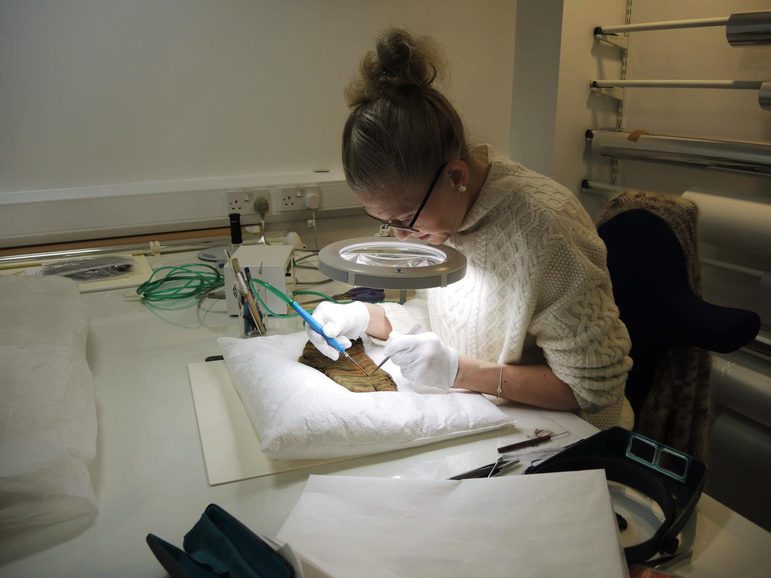
Egyptian sock being carefully cleaned by conservator Miriam McLeod using a Museum mini-vac during first stage treatment.
With some apprehension, I embarked on the sensitive humidification process using a chamber with a transparent cover and a hygrometer to monitor the changing RH (relative humidity) levels. I placed muslin strips lightly dampened with filtered water around the sock. I added more gradually until over three hours later the original level was raised to 70% relative humidity. This was as high as the sock should be taken given its vulnerable condition.
At this point I used the ankle opening to insert loosely bundled silk into the inside of the sock, and with very careful handling I was able to gently bring out the profile. A long, rigid fold (possibly caused by fluid seepage) running lengthwise down one side of the sock was too brittle to treat, and the sock lilts somewhat to one side because of the imbalance.
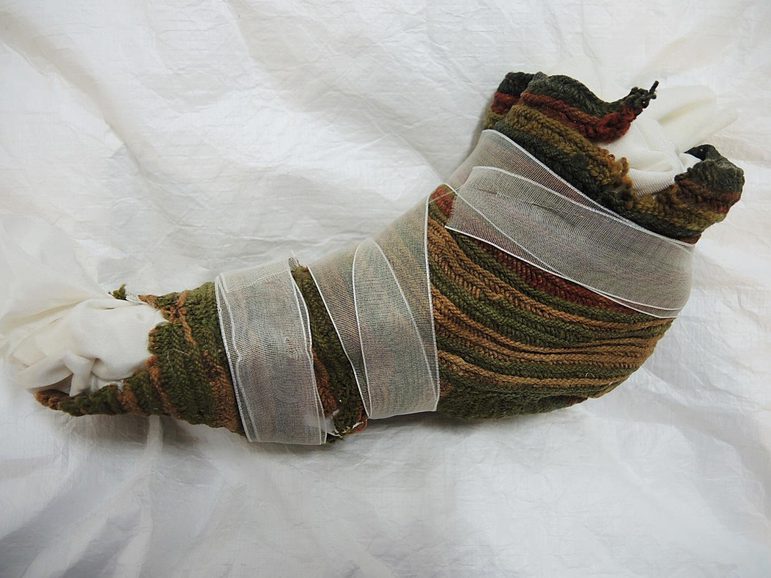
Egyptian sock braced with silk crepeline ribbons following humidification.
Supporting the sock
The first type of support the sock needed was an internal mount. I made a two-piece mount from a thermoplastic polyfelt called Fosshape™ padded out with polyester wadding. The two-piece style aids placement of the mount into the sock without the need to flex it unduly at the ankle as it is positioned inside. The mounts were top covered with silk habotai colour matched with the green of one of the sock stripes.
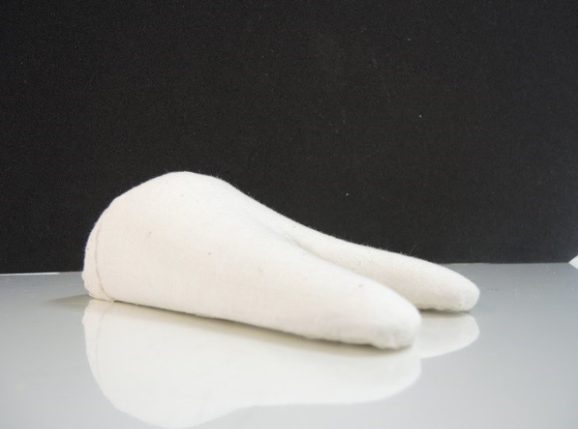
The sock mount before it was covered in silk.
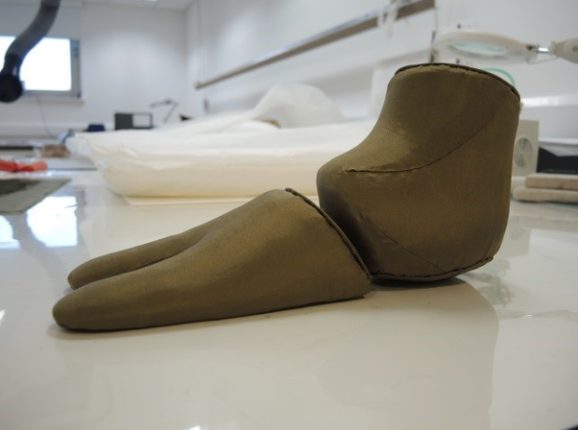
The sock mount covered with silk habotai colour that matched with the green of the sock.
The second stage was to place fabric support patches underneath the holes. I chose to use a custom-dyed brown silk crepeline, a material that is semi-transparent. I wanted this quality to help enhance understanding of the object; for instance, one of the sock holes in the big toe can still give a fascinating glimpse inside the garment with this choice of support cloth.
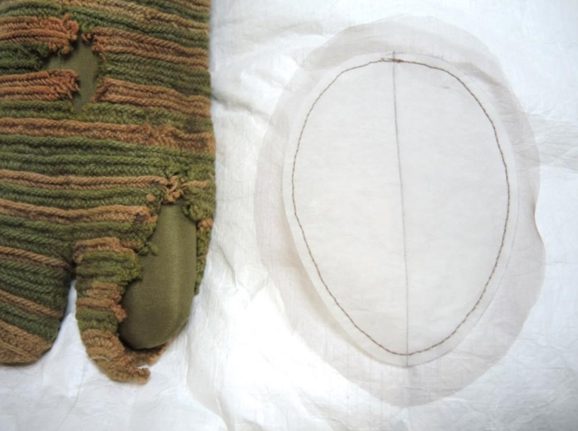
Silk crepeline support patch cut to cover the exposed toe.
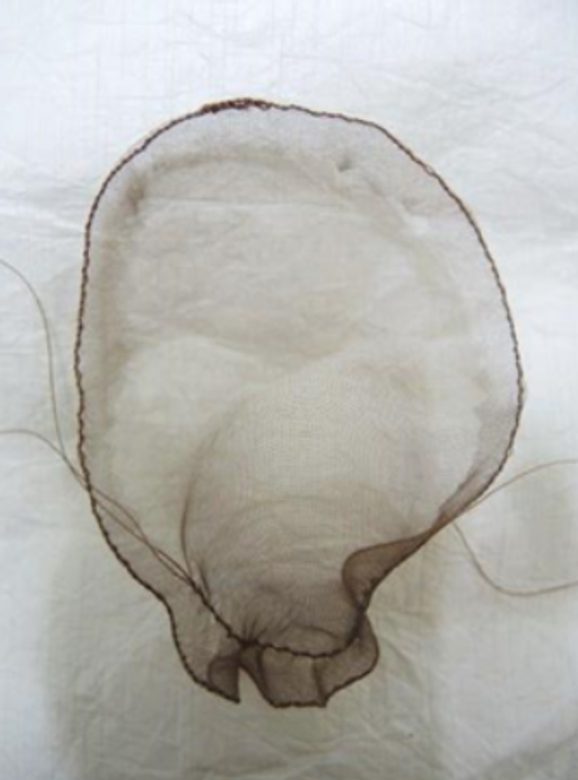
Toe patch cut from custom-dyed brown silk crepeline gathered to shape.
Everything went as planned with the support patches, although it must be said that adding a much lighter cloth to a ribbed material with a much denser structure is not without its challenges. Alignment of the weaves was a particular challenge as the different weights and surface characteristics inevitably leads to fractional movement between the materials when stitching. However, the key thing was the crepeline felt right for the object; a nice light addition that once in place, provided an appropriate level of structural support to stabilise the sock.
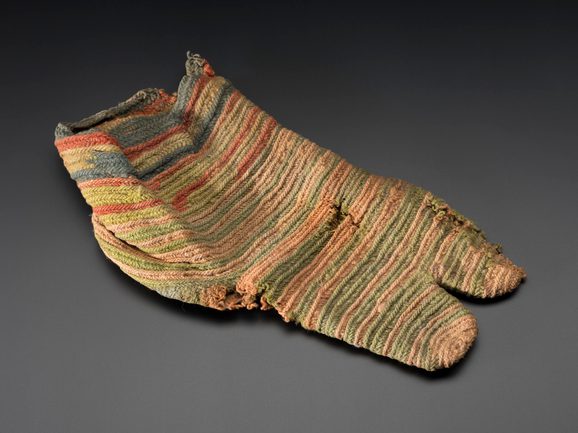
Egyptian sock before conservation. Museum reference A.1911.315.
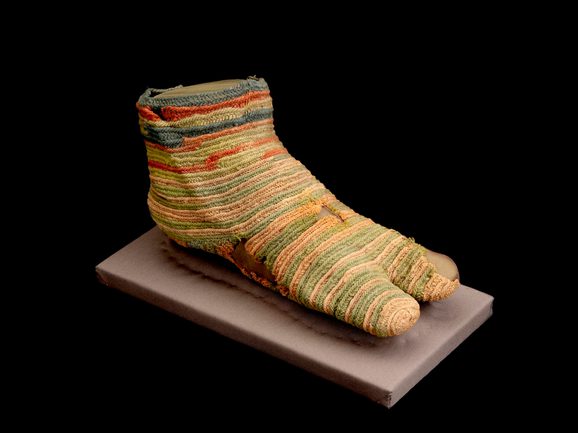
The Egyptian sock on display after conservation. Museum reference A.1911.315.
Finally, I chose to stabilise the top of the sock with a flexible strip of Melinex®, a clear conservation grade plastic, rather than make the mount wider and ‘fill’ the shape completely, as can be done with internal supports. In doing so I hoped to visually imply that the sock was on a foot, whilst providing edge support. The sock is now stabilised and with environmental care in place too; this curious, yet everyday, object can be enjoyed by audiences and safely stored for years to come.
The sock (museum reference A.1911.315) is currently on display in the Ancient Egypt Rediscovered gallery on Level 5 in the National Museum of Scotland.
Written by
Miriam McLeod
Conservator
